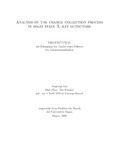Citation link:
https://nbn-resolving.org/urn:nbn:de:hbz:467-3885Files in This Item:
| File | Description | Size | Format | |
|---|---|---|---|---|
| kimmel.pdf | 12.53 MB | Adobe PDF |  View/Open |
| Dokument Type: | Doctoral Thesis | metadata.dc.title: | Analysis of the charge collection process in solid state X-ray detectors Analyse des Ladungssammlungsvorgangs in Halbleiter-Röntgendetektoren |
Authors: | Kimmel, Nils | Institute: | Fachbereich 7, Physik | Free keywords: | Bauelementephysik, Beweglichkeit <Physik>, Röntgenstrahlung, Charge-Coupled-Device, Radiation Detector, X-ray Astronomy, Synchrotron Radiation, Electron Mobility | Dewey Decimal Classification: | 530 Physik | GHBS-Clases: | UIGD | Issue Date: | 2008 | Publish Date: | 2009 | Abstract: | Physics with X-rays spans from observing large scales in X-ray astronomy down to small scales in material structure analyses with synchrotron radiation. Both fields of research require imaging detectors featuring spectroscopic resolution for X-rays in an energy range of 0.1keV to 20.0keV. Originally driven by the need for an imaging spectrometer on ESA's X-ray astronomy satellite mission XMM-Newton, X-ray pnCCDs were developed at the semiconductor laboratory of the Max-Planck-Institute. The pnCCD is a pixel array detector made of silicon. It is sensitive over a wide band from near infrared- over optical- and UV-radiation up to X-rays. This thesis describes the dynamics of signal electrons from the moment after their generation until their collection in the potential minima of the pixel structure. Experimentally, a pinhole array was used to scan the pnCCD surface with high spatial resolution. Numerical simulations were used as a tool for the modeling of the electrical conditions inside the pnCCD. The results predicted by the simulations were compared with the measurements. Both, experiment and simulation, helped to establish a model for the signal charge dynamics in the energy range from 0.7keV to 5.5keV. More generally, the presented work has enhanced the understanding of the detector system on the basis of a physical model. The developed experimental and theoretical methods can be applied to any type of array detector which is based on the full depletion of a semiconductor substrate material. Physik mit Röntgenstrahlen befasst sich sowohl mit grosskaligen Strukturen in der Röntgenastronomie, als auch mit kleinskaligen Phänomenen bei Strukturanalysen mit Synchrotronstrahlung. In beiden der genannten Bereiche werden bildgebende Sensoren benötigt, die zusätzlich als Spektrometer im Energiebereich von 0.1keV bis 20.0keV arbeiten. Ursprünglich wurden pnCCDs am Halbleiterlabor der Max-Planck-Institute für Physik und extraterrestrische Physik entwickelt, um ein bildgebendes Spektrometer für die Röntgenastronomiemission XMM-Newton der ESA bereitzustellen. Das pnCCD ist ein Detektor mit Pixelstruktur, der vom Infraroten über optische und UV-Strahlung bis hin zu Röntgenstrahlung empfindlich ist. Diese Arbeit beschreibt die Bewegung von Signalelektronen vom Zeitpunkt ihrer Erzeugung bis zur Sammlung in den Speicherzellen der Pixelstruktur. Zur experimentellen Untersuchung von pnCCDs wurde ein Lochraster eingesetzt, das deren Oberfläche mit hoher räumlicher Auflösung abtastet. Mit Hilfe von numerischen Bauelementesimulationen stand ein Werkzeug zur Modellierung der elektrischen Bedingungen in pnCCDs zur Verfügung. Durch die Kombination der durchgeführten Experimente und Simulationen konnte ein Modell für die Signalladungsdynamik im Energiebereich von 0.7keV bis 5.5keV erstellt werden. Im allgemeineren Sinne hat die vorliegende Arbeit mittels eines physikalisches Modells das Verständnis von pnCCDs erweitert. Die dazu entwickelten experimentellen und theoretischen Methoden können auf jeden Detektor angewendet werden, der auf einem vollständig verarmten Halbleitersubstrat aufbaut. |
URN: | urn:nbn:de:hbz:467-3885 | URI: | https://dspace.ub.uni-siegen.de/handle/ubsi/388 | License: | https://dspace.ub.uni-siegen.de/static/license.txt |
| Appears in Collections: | Hochschulschriften |
This item is protected by original copyright |
Page view(s)
582
checked on Jan 13, 2025
Download(s)
184
checked on Jan 13, 2025
Google ScholarTM
Check
Items in DSpace are protected by copyright, with all rights reserved, unless otherwise indicated.

